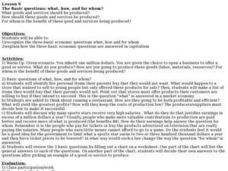Curated OER
The Basic Questions: What, How, and For Whom?
Students review the various types of economic systems. As a class, they identify the three basic economic questions: what?, How?, and For Whom?. Using capitalism as an economic system, they discuss how each question is answered.
Curated OER
Money as a Means of Exchange
First graders discover the term bartering as used to pay for wanted items. They play a bartering game to discover exchanging goods for wanted items and play the computer money game on the "Show-Me Economics" web site.
Curated OER
Goods and Services?
Learners distinguish between goods and services, and identify that goods and services are used to satisfy needs and wants. They view illustrations from books to find and chart examples of good and services and make connections that goods...
Curated OER
Traveling the Silk Road
Pupils take a virtual trip down the Silk Road. Using a map, they trace the location of the trade route and others that were developed later. They use different spices and goods to trace how they came to the Americas. They answer...
Curated OER
Give and Take
Second graders explore the concepts of goods, services and community. They go on a community walk, find businesses and logos within their community, read books about communities, and compare various goods and services. They pick a job...
Curated OER
Goods for You!
Students define "goods" and "services" and identify examples of both. They read farm books and discuss what we use from animals and plants on a farm. They observe the Wisconsin quarter reverse and locate Wisconsin on a map.
Curated OER
Occupational Circles
Students distinguish service occupations from product occupations by looking at photographs and listening to descriptions of each one. They choose an occupation that interests them and decide if it is a service or product occupation.
Curated OER
Identifying Natural Resources
Third graders identify natural resources within SE Utah and the Four-Corners regional environment, that provide for community development.
Curated OER
What is Taxed and Why
Students are exposed to the need for federal, state and local governments to tax constituents to provide goods and services for their residents. They identify the different kinds of taxes and give examples of the goods and services taxed.
Curated OER
Where is Agriculture?
Students study agriculture. In this agriculture lesson, students investigate how agriculture helps to meet a family's needs. Students identify things in their home that began as agriculture.
Curated OER
Heave, Ho the Cargo!
Students identify, sort and graph samples of goods from the Great Lakes. In this science and math lesson, students describe a "good" and sort them into living and non-living categories. Students graph the results.
Curated OER
TRADERS' GAME
Middle schoolers play a game aimed at demonstrating how relationships with other communities or countries affect the food and fiber system. The game simulates the unequal distribution of natural resources which creates the need for...
Curated OER
Goods and Services Scavenger Hunt
First graders conduct research into the concepts of goods and services. The information is used in order to create a definition for each concept. Then the information is organized using the scavenger hunt format. Further extension to the...
Curated OER
Goods and Services
Students describe the difference between goods and services. Using magazines, they work together to create a collage in which they note the differences between goods and services. They present their collage to the class and complete a...
Curated OER
Texas Industries Then and Now
Middle schoolers identify contemporary economic counterparts to industries featured in Texas bird's-eye views by using this website and a "Goods and Services Data Collection Sheet."
Curated OER
The Magic of Markets
Students examine how exchange is trading goods and services with people for other goods and services or money. They examine how people voluntarily exchange goods and services because they expect to be better off after the exchange.
Curated OER
Community Helpers Wheel
Learners play a game to reinforce the understanding that some community helpers are producers of goods, and some provide a service. Students identify community helpers and their jobs.
Annenberg Foundation
Annenberg Learner: Renaissance: Exploration and Trade
Detailed introduction on exploration and trade during the Renaissance. Provides an overview of the tools created during the Middle Ages that made such travels by sea possible as well as insight into the types of goods traders sought in...
Federal Reserve Bank
Federal Reserve Bank of St. Louis: Monster Musical Chairs [Pdf]
A lesson based on the book, Monster Musical Chairs, by Stuart J. Murphy. Students learn, through a game of musical chairs, that any supply of goods is limited and not everyone's wants will necessarily be met.
Utah Education Network
Uen: Give and Take
Learn about the concepts of goods, services, and community.
PBS
Pbs Learning Media: Primary Source Set: The Columbian Exchange
This collection uses primary sources to explore the Columbian Exchange.
Hartford Web Publishing
World History Archives: Hartford Web Publishing: The Significance of Wampum
This site contains information about the term Wampum and its significance. Also contains information about Native Americans collecting shells and their worth to the tribe.
University of Missouri
University of Missouri: Wise Pockets: Berenstain Bears' Trouble With Money
Using a Berenstain Bears' book, learners are introduced to concepts such as spending, goods, services, income, saving, and interest. Lesson is detailed and has good activities. Includes questions about the story that teach students about...
Beacon Learning Center
Beacon Learning Center: Business Buddies
Help characters Lisa and Drew learn simple economic principles by choosing what goods they will need for their lemonade stand. Continue exploring economic concepts by determining the producers, services, and consumers associated with the...




















![Federal Reserve Bank of St. Louis: Monster Musical Chairs [Pdf] Lesson Plan Federal Reserve Bank of St. Louis: Monster Musical Chairs [Pdf] Lesson Plan](https://d15y2dacu3jp90.cloudfront.net/images/attachment_defaults/resource/large/FPO-knovation.png)


